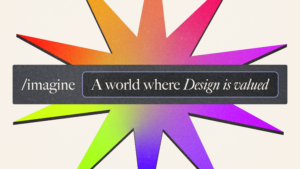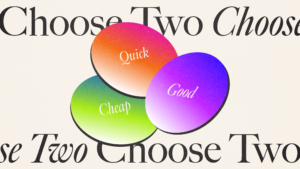
Recently I was fortunate to attend The Design Conference in Brisbane, courtesy of Gemba. Listening to a variety of established creatives encouraged me to reflect on our industry. In an already challenging environment for valuing design, AI is making it increasingly more difficult. For most of us, AI has made its way into our work, or at least our conversations. As a designer, the idea of AI was frightening. Suddenly, there was this technology that could replicate parts of what I do, and its quality has developed significantly in the past year. So, the question is, how do we fight to show the value of all the designers out there who are creating work with amazing skills, storytelling, and soul?
In every workplace there is an inevitable sense of urgency. The problem with accelerating projects and tight deadlines is the work always suffers. I love to refer to the ‘Quick vs Cheap vs Good’ diagram (image below) as a way of helping non-designers understand the dilemma we often find ourselves in. Clients are rightfully asking for the best work, but, if you want great work, it needs to come with both financial and time investments. It’s important to recognise that when navigating the contrasting needs between clients and designers, we need to realign on the balance between delivering high-quality work and providing the necessary foundations – reasonable time and investment – for designers to do so. Time is always a precious resource, however, if we can find ways to re-frame our approach towards Design and give some of that time back to our designers, we will have the chance to create work that is not only meaningful to us, but that is effective and beautiful.
Niceshit, an independent animation studio based in Barcelona, cements this balance, communicating their central value of ‘we don’t do urgent’ to their clients. Through doing this, they aim to alleviate the stress and anxiety that can result in the deterioration of their team’s wellbeing and culture. They are striving to demonstrate that it is possible to create an environment where creativity thrives and clients are satisfied. So, how can we collectively cultivate a safe space to make meaningful work and stay true to our values?

In the current state of the industry, we can be subject to impossible timelines, given vague briefs along the lines of “make it pop” and we must execute the exact thoughts of senior art directors, with little room for our own creativity. For a lot of agencies, Design is seen as an execution and creativity as a commodity. Due to the nature of a transactional and heavily criticised industry, designers can be left with imposter syndrome and burn out. 67% of professional creatives regularly experience a lack of motivation and just 7% consider their workday to be close to ideal (Emmi Salonen, 2024). Emmi Salonen, who I recently heard speak at The Design Conference, has developed a model of Creative Wellbeing, seeking to find ways to ensure a balance between creative output and nourishing input. Salonen contends that creatives need to re-frame their approach to work, starting with asking themselves what brings them joy. “What were you last doing when you lost track of time?” (Emmi Salonen). “Because if time slows down, you are doing something right” (Matthew Haynes, 2024).
Whilst I have opinions on our industry’s direction, I personally do not have the solution. We tend to avoid problems when we don’t have an easy solution, however, Ariella Bodenstein and Claudia Henderson from For The People taught me that it’s okay to not know what the end result looks like, but instead it’s the act of trying to make change that will move our industry forward. This is also where AI is failing us. Work is becoming oversimplified, turning complex topics into something palatable, resulting in it often becoming generic, passive and ultimately ineffective. Although there is no doubt that applications of AI are helpful, it inarguably removes the human element of discovery, wonder and inspiration. We rely on our technology to give us the answers we need at the touch of a button and remove any need to deeply research and understand the problems we seek to solve. Facing our problems, big or small, without looking to technology for answers, will allow us to uncover new and exciting solutions.
I’m not here to talk down the design industry, scold clients or deter any aspiring designers. I absolutely love being a designer and wouldn’t choose to be anything else, however, there is still room for improvement. Burnout is common across all creative roles; tight timelines aren’t going anywhere and we’re not going to solve any of these problems overnight. Nevertheless, I am hopeful. It was an incredible experience to be immersed in the Design community at The Design Conference. I had many thought-provoking conversations with other designers and there seems to be a consensus: if we can continue to gather with like-minded creatives, discussing the issues we face and challenges we share, then there is only a positive and exciting future ahead for us.
Learn more about The Design Conference: https://www.thedesignconference.com.au/
Read the Creative Wellbeing Insights research by Emmi Salonen: https://www.creativeecosystem.org/